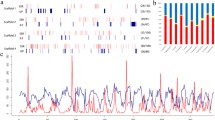Abstract.
Microsatellite clustering may account for genetic maps which do not coalesce into the expected number of linkage groups. Microsatellite organization within the large genome of Pinus taeda (1C=20,000 Mb) was determined by (1) testing whether repeat motifs were sequestered within the low-copy DNA kinetic component and (2) testing for repeat motif clusters within DNA fragments regardless of copy number. Within the low-copy kinetic component, either (AC)n or (AG)n repeat units were present in 32% of sequences. No repeat motifs were found in the total genome control. Clustered repeat motifs were frequent; the (ATG)n triplet repeat motif was located upstream from a CG-rich trinucleotide microsatellite in 26 out of 44 microsatellite sequences. Fourteen of the clustered (ATG)n sequences could be assembled into four microsatellite sequence families based on similarities in the flanking regions. Consistent with the DNA turnover model, family members shared similar flanking regions but differed in repeat motif composition and length.
Similar content being viewed by others
Author information
Authors and Affiliations
Additional information
Electronic Publication
Rights and permissions
About this article
Cite this article
Elsik, C., Williams, C. Families of clustered microsatellites in a conifer genome. Mol Gen Genomics 265, 535–542 (2001). https://doi.org/10.1007/s004380100443
Received:
Accepted:
Published:
Issue Date:
DOI: https://doi.org/10.1007/s004380100443




